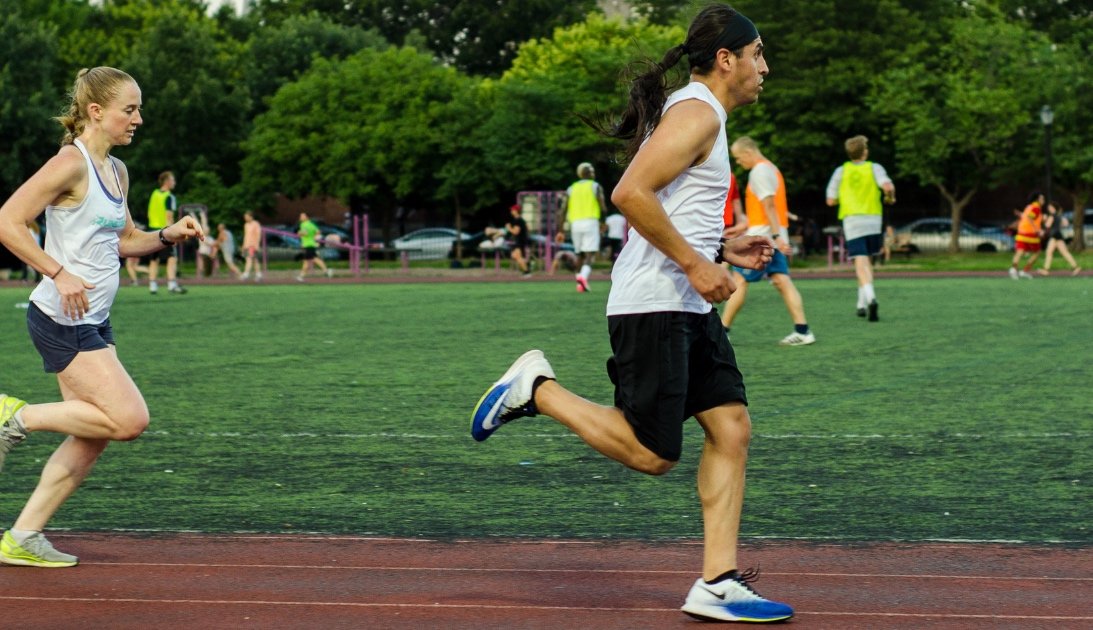How to Do Mile Repeats to Get Faster
Runstreet track photo by Marques Jackson Photography.
By Marnie Kunz,
Certified trainer and run coach
Mile repeats are a versatile speed workout that can help you get faster and run more efficiently for races ranging from the 5K to the marathon. Whether you’re a beginning runner or a veteran road warrior, doing mile repeats can make you a better runner. This guide will go over the benefits of running mile repeat workouts as well as offer some sample workouts you can add to your running routine. As a running coach, I often give mile repeats workouts to clients who want to hit their goal marathon or half-marathon pace. The longer intervals are especially helpful for building endurance and speed for race day.
Related Post: Best Half Marathon Workouts to Get Faster
What Is a Mile Repeat?
Mile repeats are a form of running speed workout that involves running 1-mile intervals at a challenging pace, often at your goal race pace, followed by recovery segments. The alternating periods of higher intensity, fast running and recovery jogging make repeats a form of interval training (which is different from tempo runs, which involve a steady pace and effort).
Mile repeats are a type of running workout that can also be used to target your threshold pace - the comfortably hard intensity you would be able to sustain for about an hour. This makes them effective not just for speed, but also for improving your lactate threshold.
A mile repeat workout may include a mile of jogging to warm up and then one mile at your goal race pace, 4 minutes of recovery running, and repeating to do three total miles at your goal race pace and three recovery segments, plus a warm-up and cool down.
The beauty of mile repeats is that they offer an accessible speed workout that can be adapted to your fitness level and race distance. If you’re training for a marathon, for instance, you may do 5 or 6 mile repeats. If you’re a beginner training for a 5K or shorter race, you may start with 2 mile repeats and work your way up to doing 3. Do a warm up and cool down at an easy pace.
Benefits of Mile Repeats
There are many physical and mental benefits of doing mile repeats. They help train your body and mind to run at your race pace even when you’re fatigued. Here are some of the main rewards of doing these mile-based workouts regularly:
Improve your speed. Doing regular mile repeat workouts will make you a faster runner.
Run more efficiently. These speed workouts will improve your VO2 Max, which is the amount of oxygen your body uses to make energy. This will make you a more efficient runner.
Better stamina. Doing mile repeats trains your body to run fast even when you're fatigued, improving your endurance for longer races like half marathons or marathons.
Improved cardiovascular fitness. Mile speed workouts boost your fitness level, making you a better athlete.
Build leg strength. You will have stronger legs and build type I slow twitch muscle fibers and type II fast-twitch muscles, which will also boost your metabolism. Type II muscles decline with age, according to the American Council on Exercise, so strengthening them offers anti-aging benefits.
Add variation to longer speed workouts. In contrast with tempo runs, mile repeats break up your workout into smaller stretches so you have recovery time during your workout and more changes throughout your run, which can help prevent boredom.
How to Run Mile Repeats
With so many benefits, you’re probably toeing the line to begin mile repeats. Here are some tips to help you get started:
Measure your distance. An easy way to know how far you’re running is to go on an outdoor track (4 laps on a standard track is 1 mile), run on a treadmill, or use a GPS running watch. If you’re running on the road I recommend using a GPS watch or a smartphone running app, but make sure you’re in an area with a good GPS signal so you get an accurate pace reading.
Go slow on recovery segments. Runners I coach often try to go too fast on the recovery portion of interval workouts. Do an easy run pace for your recovery intervals and you'll be able to go faster on your mile reps. Your warmup and cooldown should also be at a very relaxed, easy pace.
Build gradually. If this is your first mile repeat workout or you’re just getting back into running after a break, ease into it by doing 2 X 1-mile repeats. See the sample beginner’s program for the exact workout. As you advance in your training (and if you’re preparing for a long-distance race such as a half marathon or marathon), you can gradually add more mile repeats to your workouts.
Be consistent. As a running coach, I recommend that runners do a minimum of one speed workout a week to get faster and a maximum of three speed sessions per week (with two being the sweet spot for most runners). Consistency is important to see results and keep in mind that it will take you about a month to start seeing an improvement in your speed from doing speed workouts.
Sample Workouts
Try this mile repeats workout to prepare for your next race.
Here are some mile repeat workouts you can incorporate into your training cycle. If you need a personalized running training plan, check out our Training Center to find the best options.
Beginner’s Mile Repeat Workout
Best for: New runners, those just getting back into running, and training for short to medium-distance races of 5K or 10K.
1 mile jogging to warm up
1 mile at goal race pace
4 minutes slow recovery running
1 mile at goal race pace
4 minutes slow recovery running
1 mile to cool down
Note: You can add or subtract distance from your warm-up and cool-down to change your total workout mileage and suit your fitness level. As you adjust to this workout, you can add more mile intervals to do a total of 3 repeats for 5K training and 4 to 5 repeats for 10K training.
Intermediate Mile Repeat Workout
Best for: Intermediate-level runners who are accustomed to doing some speed work, and training for medium-distance races of 10K and half marathons.
1 mile jogging to warm up
1 mile at goal race pace
2 minutes slow recovery running
Repeat to do 4 mile repeats and 4 recovery segments
1 mile to cool down
Note: As you adjust to this workout, you can add more mile intervals to do a total of 5 for 10K training and 6 for half marathon training.
Marathon Mile Repeat Workout
Best for: Intermediate and advanced-level runners who are training for a marathon.
1 mile jogging to warm up
1 mile at your goal marathon pace
2 minutes slow recovery running
Repeat to do 5 mile repeats and 5 recovery segments
1 mile to cool down
Note: As you adjust to this workout, you can add more mile intervals to do a total of 6 repeats.
How Often to Do Speed Workouts
Mile repeats are a great speed training workout that you can add to your running toolbox. Do 1 to 3 speed workouts a week to become a faster runner. Make sure to ease up on your training and speed workouts to taper before your race.
Have you tried mile repeats? Follow and tag @Runstreet on Instagram to share your workouts and get cheered on.
Check out my 10 Best Speed Workouts for Runners for more interval workouts that will help you run faster and crush your next race. For a training program to slay your next race, visit the Runstreet Training Center.
Happy running to you!😊👟
Related Posts: How to Taper Running, Speed Workouts for Every Race Distance
Marnie Kunz is a NASM-certified trainer and USATF- and RRCA-certified running coach, a dog lover, an Akita mom, and the founder of Runstreet. She specializes in helping runners get faster and stronger and helping beginners elevate their fitness levels. She is based in Brooklyn, New York.




